Gordon Hartshorne
nature interpreted
Sight and Sound: The Woodcut Prints of Gordon Hartshorne
“Animals talk to each other, of course. There can be no question about that; but I suppose there are very few people who can understand them,” mused Mark Twain in the opening lines of “Jim Baker’s Blue Jay Yarn.” The title of this short story was scrawled into the notebook of artist Gordon Hartshorne, who spent years attuned to the sounds of juncos, warblers, bitterns, sparrows, orioles, and ospreys outside of his home in Chicago and on excursions to the northern woods of the Midwest and to the Gulf Coast. Hartshorne recorded their habits and sketched their woodland haunts and flights over water in the pages of his notebooks. While he may not have understood their tongue, he translated these empirical observations into a vibrant visual language, creating a thirty-year body of work in woodcut prints. These woodcuts mapped his travels across the country and expressed his distinctive vision of the American landscape.
Reconsidering Woodcut Printing
“It seemed to me that making woodcuts was a simple and direct way of creating images of nature.” —Gordon Hartshorne in American Artist, 1990
It may initially seem like an antiquated choice for an artist to select woodcuts as his or her primary medium. However, Hartshorne explained his use of the art form in an article he published in American Artist magazine in November 1990. Within the pages, he advised readers—most likely fellow artists—to reconsider woodcut printing for its honest materials and simple technique.
For centuries, artists have printed from wood blocks. The process was invented in China in the sixth century, introduced to Japan in the eighth century, and reached Europe in the fourteenth century. In 1976, Hartshorne began making woodcuts in the Japanese tradition. The procedure is straightforward. To create a woodcut, a sketch is first transferred onto a plank of wood. Flat gouges and sharp knives remove the areas around the lines of the sketch, the negative spaces that will not be printed. The cut block is then inked. Finally, a piece of rice paper is placed on the wood and rubbed with a wooden spoon, which transfers the relief image of the block onto the paper.
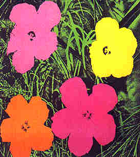 The simplicity of the process and tools advocated by Hartshorne, however, belies the arduous effort made on the part of the printmaker to carve into the plank, while simultaneously navigating the fine details of a sketch. Furthermore, multiple planks are often carved from the same sketch for applying separate colors. The artistic dexterity in chiseling forms out of the wood can be seen in Hartshorne’s own work, particularly in the thicket of branches in the nearly monochromatic Cardinal Environment and in the delicate grasses and wildflower stems of Along the Path, which incidentally recall the fluorescent silkscreened canvases of fellow graphic designer Andy Warhol from the 1960s (fig. 1).
The simplicity of the process and tools advocated by Hartshorne, however, belies the arduous effort made on the part of the printmaker to carve into the plank, while simultaneously navigating the fine details of a sketch. Furthermore, multiple planks are often carved from the same sketch for applying separate colors. The artistic dexterity in chiseling forms out of the wood can be seen in Hartshorne’s own work, particularly in the thicket of branches in the nearly monochromatic Cardinal Environment and in the delicate grasses and wildflower stems of Along the Path, which incidentally recall the fluorescent silkscreened canvases of fellow graphic designer Andy Warhol from the 1960s (fig. 1).
Despite the challenging nature of working the material, woodcuts are compelling for the aesthetic potential of its surface. The circular rings of the wood grain also soak in ink during the printing process, becoming visible when paper is applied to the block. Hartshorne utilized the elegance inherent in the material to enhance his own impressions of nature. In Bay with Lily Pads, sunlight reflects off of a ribbon of water flowing diagonally through the center of the image. Rather than cover the wood grain with gesso, as printmakers often do, Hartshorne underscored the organic nature of his material and allowed the meandering wood rings to become ripples lapping towards the shoreline.
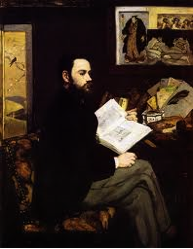 In addition to using his material to capture the patterns within nature, woodcut printing also allowed Hartshorne to access a rich visual tradition. He followed in a long line of modern artists attracted to the process and aesthetic of Japanese printmaking. After Japan opened to international trade in 1858, a craze for its design seized the fine and decorative artists of Europe. The French Impressionists and the Post-Impressionists were particularly inspired by the graphic patterns; simple, asymmetrical compositions; thick contour lines; and bright, flat colors of Japanese art to reinvigorate western traditions. One of the most well known works of art commemorating this blending of European modernism and Japanese art is Edouard Manet’s portrait of friend and critic, Emile Zola (1868). Two Japanese objects literally frame Zola, who shared Manet’s pictorial interests: a Japanese print is depicted above Zola’s writing desk and a Japanese painted screen anchors the left edge of the painting (fig. 2).
In addition to using his material to capture the patterns within nature, woodcut printing also allowed Hartshorne to access a rich visual tradition. He followed in a long line of modern artists attracted to the process and aesthetic of Japanese printmaking. After Japan opened to international trade in 1858, a craze for its design seized the fine and decorative artists of Europe. The French Impressionists and the Post-Impressionists were particularly inspired by the graphic patterns; simple, asymmetrical compositions; thick contour lines; and bright, flat colors of Japanese art to reinvigorate western traditions. One of the most well known works of art commemorating this blending of European modernism and Japanese art is Edouard Manet’s portrait of friend and critic, Emile Zola (1868). Two Japanese objects literally frame Zola, who shared Manet’s pictorial interests: a Japanese print is depicted above Zola’s writing desk and a Japanese painted screen anchors the left edge of the painting (fig. 2).
 We can visually link Hartshorne to Manet’s portrait and this modernist interest in Japanese art in the screen visible to the left of Zola. The avian motif and strong diagonal lines of the tree branches are also evident in Hartshorne’s Kentucky Warbler. Graceful and simplified, Hartshorne’s arrangement includes three diagonal branches of a flowering tree, on which rests a bright yellow-plumed songbird against a background of soft blue. Hartshorne’s visual sources (as well as Manet’s) were most likely the Japanese printmakers of the Edo Period, such as Utagawa Hiroshige (fig. 3) and Katsushika Hokusai (fig. 4), who specialized in depictions of birds and flowers.
We can visually link Hartshorne to Manet’s portrait and this modernist interest in Japanese art in the screen visible to the left of Zola. The avian motif and strong diagonal lines of the tree branches are also evident in Hartshorne’s Kentucky Warbler. Graceful and simplified, Hartshorne’s arrangement includes three diagonal branches of a flowering tree, on which rests a bright yellow-plumed songbird against a background of soft blue. Hartshorne’s visual sources (as well as Manet’s) were most likely the Japanese printmakers of the Edo Period, such as Utagawa Hiroshige (fig. 3) and Katsushika Hokusai (fig. 4), who specialized in depictions of birds and flowers.
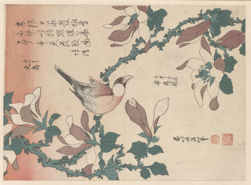 In addition to Japanese art, Hartshorne’s woodcuts can be in dialogue with other art styles. In the early twentieth century, members of the German Expressionist movement Die Brücke embraced the coarseness and hard lines inherent in woodcuts to convey intense inner emotions. Erich Heckel’s Portrait of a Man (1919) (fig. 5), for instance, exudes melancholy and human fracture through the use of rigid, angular contour lines that build the face and hands. While the pathos in this print and in other works by the German Expressionists is not necessarily transferred into Hartshorne’s work, we can find Hartshorne grappling with the range of emotions that can be communicated within the woodcut medium. The stark Treetop Crows,
In addition to Japanese art, Hartshorne’s woodcuts can be in dialogue with other art styles. In the early twentieth century, members of the German Expressionist movement Die Brücke embraced the coarseness and hard lines inherent in woodcuts to convey intense inner emotions. Erich Heckel’s Portrait of a Man (1919) (fig. 5), for instance, exudes melancholy and human fracture through the use of rigid, angular contour lines that build the face and hands. While the pathos in this print and in other works by the German Expressionists is not necessarily transferred into Hartshorne’s work, we can find Hartshorne grappling with the range of emotions that can be communicated within the woodcut medium. The stark Treetop Crows, for instance, conveys a subtle sense of foreboding. The black forms of the crows, thrown into relief by the absence of a background, dominate our visual field and induce an ominous mood.
for instance, conveys a subtle sense of foreboding. The black forms of the crows, thrown into relief by the absence of a background, dominate our visual field and induce an ominous mood.
As Hartshorne articulated in American Artist magazine, making woodcuts was the simplest means for him to create images of nature. His method, techniques and style, however, also places him in a lively dialogue with the artists of Asia and Europe, adding visual and historical complexity to his prints.
Landscape and the American Tradition
“In such a day, in September or October, Walden is a perfect forest mirror, set around with stones as precious to my eye as if fewer or rarer. Nothing so fair, so pure, and at the same time so large, as a lake, perchance, lies on the surface of the earth. Sky water. It needs no fence.” —Henry David Thoreau in Walden, 1854
Hartshorne’s empirical interest in rocks, clouds, trees, flora, fauna, and water align him with the American landscape artists of the nineteenth century, such as Thomas Cole, Asher B. Durand, and Albert Bierstadt, who turned their eyes to the study of nature and its topography to define a uniquely American identity. For them, the land held political, poetic and symbolic potential. The motif of the American sublime also developed at this time, when artists amplified the scale of their pictures to capture the humbling power of thunderous waterfalls and the majesty of the new nation’s mountain ranges. Some artists were guided by Manifest Destiny to aggrandize the vistas of the unconquered west—land they believed was divinely given.
Today, these landscapes have, for the most part, been developed from coast to coast. National parks and preserves are the partitioned remains of what once was a seemingly endless and unadulterated expanse of land. With a spiritual, rather than religious agenda, Hartshorne continued in the American artistic tradition, mining the national woodlands, lakes, and coasts for moments of visual purity.
Hartshorne often visited and hiked in the parks of the north woods of Wisconsin, Michigan and Minnesota. It was there where he brought his notebooks to record his solitary musings on nature and its inhabitants in the dedicated manner of transcendentalist Henry David Thoreau, an author he often cited in his notebooks. “Don’t forget the sounds of the wind through the trees and dripping rain, running water of the streams, lapping water on the shore,” Hartshorne wrote in one such entry. He later laments, “the man-made scars a landscape.” Most of Hartshorne’s images avoid evidence of people; our only indication that these landscapes were mediated by humankind is that the viewpoint rendered in many of the prints is that of Hartshorne’s himself—his view from the shoreline of Exploring Lake Four or his view of sunlight through the trees in Forest Opening. We stand, as observers, where he once did, at sites he felt were visually and profoundly expressive enough to record.
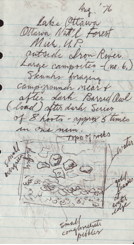 Hartshorne frequently dated his notebook entries when out in the woods or along the coast. These entries from such trips are vital resources that reveal how his excursions outdoors motivated his decision to create visual, lasting memories of his experiences. For example, his first experiments with woodcut printing can be connected to his experience hiking in the Upper Peninsula of Michigan. In an entry dated August 1976, Hartshorne noted an expedition to Lake Ottawa in the Ottawa National Forest of Michigan. Underneath this entry, he sketched an aerial view of a section of the lake, including details such as a tuft of evergreen foliage, small conglomerate pebbles, and golden leaves scattered along the water’s edge (fig. 6). Later, in his studio, Hartshorne used another sketchbook to enlarge this drawing, working out his perceptions of light and color (fig. 7). In the final steps of his printmaking process, Hartshorne cut and inked the block that would produce the print Lake Ottawa Morning, an approximate replication of the composition of his original thumbnail sketch. With a virtuosity of technique, Hartshorne enhanced the wood block with sand and glue to actualize his initial vision of the iridescent effect of light reflecting off of water and the texture of the tiny pebbles on the shoreline.
Hartshorne frequently dated his notebook entries when out in the woods or along the coast. These entries from such trips are vital resources that reveal how his excursions outdoors motivated his decision to create visual, lasting memories of his experiences. For example, his first experiments with woodcut printing can be connected to his experience hiking in the Upper Peninsula of Michigan. In an entry dated August 1976, Hartshorne noted an expedition to Lake Ottawa in the Ottawa National Forest of Michigan. Underneath this entry, he sketched an aerial view of a section of the lake, including details such as a tuft of evergreen foliage, small conglomerate pebbles, and golden leaves scattered along the water’s edge (fig. 6). Later, in his studio, Hartshorne used another sketchbook to enlarge this drawing, working out his perceptions of light and color (fig. 7). In the final steps of his printmaking process, Hartshorne cut and inked the block that would produce the print Lake Ottawa Morning, an approximate replication of the composition of his original thumbnail sketch. With a virtuosity of technique, Hartshorne enhanced the wood block with sand and glue to actualize his initial vision of the iridescent effect of light reflecting off of water and the texture of the tiny pebbles on the shoreline.
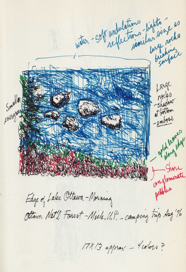 Hartshorne also modernized the genre of American landscape painting through his experiments with abstraction, color, and space. After the Storm, for example, exhibits Hartshorne’s alchemistic ability to imitate the painterly effects of watercolor painting out of cut wood. Far more abstract than his other prints, After the Storm’s washes of sky blue and violet paint evoke the meditative quality found in mid-twentieth century American color field painting. In Searching Gull, a work inspired by Hartshorne’s visits to Florida, he compressed his landscape into two horizontal bands of color, blue and green, which serve as shorthand for water and land. With an economy of means, Hartshorne captured the visual effects of the seemingly endless shoreline and skyline of the Gulf Coast.
Hartshorne also modernized the genre of American landscape painting through his experiments with abstraction, color, and space. After the Storm, for example, exhibits Hartshorne’s alchemistic ability to imitate the painterly effects of watercolor painting out of cut wood. Far more abstract than his other prints, After the Storm’s washes of sky blue and violet paint evoke the meditative quality found in mid-twentieth century American color field painting. In Searching Gull, a work inspired by Hartshorne’s visits to Florida, he compressed his landscape into two horizontal bands of color, blue and green, which serve as shorthand for water and land. With an economy of means, Hartshorne captured the visual effects of the seemingly endless shoreline and skyline of the Gulf Coast.
Hartshorne’s interest in commemorating his private sojourns into the American landscape reflects an artistic tradition epitomized by painters in the nineteenth century. However, Hartshorne also modernizes his subject matter with a high-keyed palette, spatial compression, and abstract compositions that express the poetic potential of the unscarred landscape still evident, despite all odds, in our time.
Process as Perception
“The painter can do no more than construct an image; he must wait for this image to come to life for other people. When it does, the work of art will have united these separate lives; it will no longer exist in only one of them like a stubborn dream or a persistent delirium, nor will it exist only in space as a colored piece of canvas. It will dwell undivided in several minds, with a claim on every possible mind like a perennial acquisition.”
—Maurice Merleau-Ponty in “Cezanne’s Doubt,” 1945
As a young child, Hartshorne revealed to his mother that he wanted to become an artist. After graduating from the University of Illinois with a Bachelor of Science degree, he channeled this dream towards a career as a graphic designer. In 1953, he became an art director for Rand McNally and Company, where he managed book, map, and atlas design. There, Hartshorne attended to the overall visual coherence of illustration, photography, and typography within the company’s publications. His sharp eye was attuned to the pictorial balance and clarity of the page, concerns that would become evident in the woodcut compositions he began in 1976. In Woodland Structure, for example, Hartshorne guided his composition by the principles of the golden rectangle, as seen from his sectioning of the print into various rectangular quadrants. These sections are controlled by a mathematic ratio of length to width that is believed to be the most pleasing to the eye. This ratio has been used since antiquity within architecture and art to create harmoniously balanced structures and compositions.
Hartshorne’s analytical eye also defined his process of observation in his personal work. His will to know his subjects—the birds, landscapes, and seascapes—depended on meticulous study. He often took photographs to accompany his notes, remarking on the angle of the sun, film type, speed number, focal length, and distance to his subjects, notations that would aid him to stop time—to recreate the color, light, and spatial dimensions of his views when he began printing. Yet, for all of his diligence to photographic recreation, his prints expose the handmade quality of his medium. The hardness of the material makes it difficult to assert complete control. Each cut into the wood is an index of the motion of Hartshorne’s hand; his process of creation is literally a process of inscription. His images are not reproductions of nature, but expressions of his interactions with and perceptions of his environment.
As viewers, we are drawn to his work, whether for its aesthetic, its nostalgia, or its serenity. This catalogue of woodcut prints functions as a travelogue; we are encouraged to follow along, moving visually through various times of day, seasons, regions, and memories. At the core of these prints is an interpretation of nature, a subject artists have addressed for centuries. For Hartshorne, his work was guided by the philosophy of transcendentalism—to find a profound personal connection to the world through solitude in nature. In a page in his notebook, he transcribed the following words from the journal of Henry David Thoreau: “Would it not be a luxury to stand up to one’s chin in some retired swamp for a whole summer’s day…To hear the evening chant of the mosquito from a thousand green chapels, and the bittern begin to boom from his concealed fort like a sunset gun!” These prints retain and amplify the ebullience of Thoreau’s voice. Hartshorne’s vividly colored compositions boom through the stillness of the woodlands and across the placid lakes of the north woods, reverberating off the printed page.
—Rachel White, Independent Art Historian
Fig. 1 Andy Warhol, Flowers, 1964 Silkscreen on canvas. 119.7 x 117.2 x 2.5 cm. Yale University Art Gallery, New Haven, Connecticut Gift of the Woodward Foundation, 1977.49.31
Fig. 2 Edouard Manet, Portrait of Emile Zola. Ca. 1868. Oil on canvas, 146.5 x 114 cm. Musee d’Orsay, Paris, France Credit: Réunion des Musées Nationaux / Art Resource, NY
Fig 3 Utagawa Hiroshige (Ando) (Japanese, 1797-1858). Chickadee on Cherry Branch. ca. 1840. Woodblock print, Image: 13 11/16 x 6 7/8 in. (34.8 x 17.4 cm). Brooklyn Museum, Gift of Dr. Eleanor Z. Wallace in memory of her husband, Dr. Stanley Wallace, 2005.79.7
Fig. 4 Katsushika Hokusai (Japanese, 1760-1849). Buncho kobushi no hana. Woodblock print. The British Museum. © The Trustees of the British Museum.
Fig. 5 Erich Heckel, Portrait of a Man (Männerbildnis). 1919. Woodcut. Composition: 18 3/16 x 12 3/4″ (46.2 x 32.4 cm); sheet (irreg.): 24 1/4 x 20″ (61.6 x 50.8 cm). The Museum of Modern Art, New York, NY, U.S.A. Credit: Digital Image © The Museum of Modern Art/Licensed by SCALA / Art Resource, NY
Fig. 6 From Gordon Hartshorne sketchbook.
Fig. 7 From Gordon Hartshorne sketchbook.